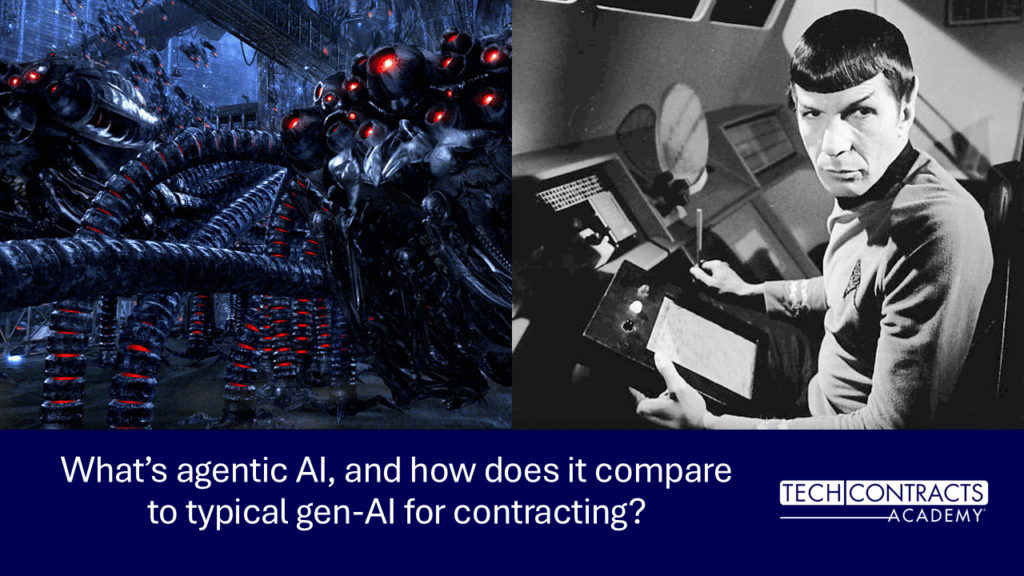In an agentic AI system, “AI agents” take autonomous action, based on preprogrammed instructions. Those actions could involve multiple steps, multiple tasks, but the AI agents still perform without human intervention: without prompts. So agentic AI requires less direction than typical gen-AI. And it can work while you sleep, while most gen-AI waits for a prompt.
In other words, typical gen-AI works like the computer on the original Star Trek (above right), which didn’t make a move without a prompt from a human (or Vulcan). Agentic AI operates like the sentinels from The Matrix (above left): autonomous AI agents that carry out a task or set of tasks on their own – killing humans, in sentinels’ case. (Of course, today’s AI agents run around within a computer system, not in The Matrix‘s underworld.)
Agentic and generative AI are not wholly separate concepts. Gen-AI models usually provide much of the functionality used by agentic AI agents.
We’ll cover contracting tools using each type of AI in our May 22, 2025 webinar, The Best AI and Other Software for Contract Drafting. But here are the basics.

Contracting with agentic and typical generative AI
A typical gen-AI user uploads a contract and instructs (“prompts”) the software to review, analyze, or redline it. The user does that by typing in a command or, in many products, clicking a button (e.g., “Review”). Or the user asks the gen-AI to draft a clause or write a memo about a contract. An agentic AI user, on the other hand, gives the “AI agent” instructions in advance: steps it should take when it receives a contract. The instructions could match the gen-AI user’s prompts, but the agentic AI doesn’t need human intervention each time. It doesn’t wait for prompts.
In theory, two agentic AIs could negotiate a whole contract and even sign it. (Few would trust an AI agent to take the last step, signature, at least for now, but someday …) In fact, an agentic AI company called Luminance just ran that experiment: two of its agents negotiated an NDA without human involvement.
In a legal department using an agentic system, AI agents could run around all day and night revising and negotiating contracts. Other AI agents might handle related tasks, like gathering pricing or other market data, communicating with staff, answering the other side’s questions, and requesting approvals.
Which is better?
There is no particular reason either form of AI should perform better or worse on the substance of legal issues. Neither has an advantage when it comes to issue-spotting, explaining legal concerns, redlining, etc. In each case, quality depends on training, programming, and the contributions of human experts. (Most AI handles a lot of those tasks badly, as I’ve mentioned in recent articles and will discuss in our May 22, 2025 webinar: The Best AI and Other Software for Contract Drafting.)
Agentic AI has an obvious advantage on tasks requiring multiple fast decisions. With humans out of the loop – or in the loop less often – work gets done in seconds. And of course, agentic AI has the broad advantage of taking more work off of human shoulders: always a huge plus.
Agentic AI’s downside: an agent could do a lot more work before a human notices a problem. For instance, your AI agent could make multiple concessions in contract negotiations before you realize it’s chosen the wrong playbook and revealed negotiation positions you’d never want anyone to know.
I suspect the future lies with agentic AI, in contract drafting and other fields. (“Hey, Agent, collect hotel and flight prices for a 10-day trip to Tahiti, determine the price-optimal days to travel this summer, and book cancellable reservations for the #1 choice hotel and flights.”) But we’re already having trouble trusting non-autonomous AI (for good reasons). So I wouldn’t expect agentic AI to take over your contracting process in the near future. We’ve got to learn to trust the tools.
Our webinar on this and related issues is The Best AI and Other Software for Contract Drafting – on May 22, 2025 at 10:00 a.m. PDT. It’s for everyone, but for California lawyers, it provides required credit under new CLE subfield: Technology in the Practice of Law. (For other jurisdictions, we provide self-reporting resources for CLE.)
THIS ARTICLE IS NOT LEGAL ADVICE. IT IS GENERAL IN NATURE AND MAY NOT BE SUFFICIENT FOR A SPECIFIC CONTRACTUAL, TECHNOLOGICAL, OR LEGAL PROBLEM OR DISPUTE, AND IT IS NOT PROVIDED WITH ANY GUARANTEE, WARRANTY, OR REPRESENTATION. LEGAL SITUATIONS VARY, SO BEFORE ACTING ON ANY SUGGESTION IN THIS ARTICLE, YOU SHOULD CONSULT A QUALIFIED ATTORNEY REGARDING YOUR SPECIFIC MATTER OR NEED.
© 2025 Tech Contracts Academy, LLC
